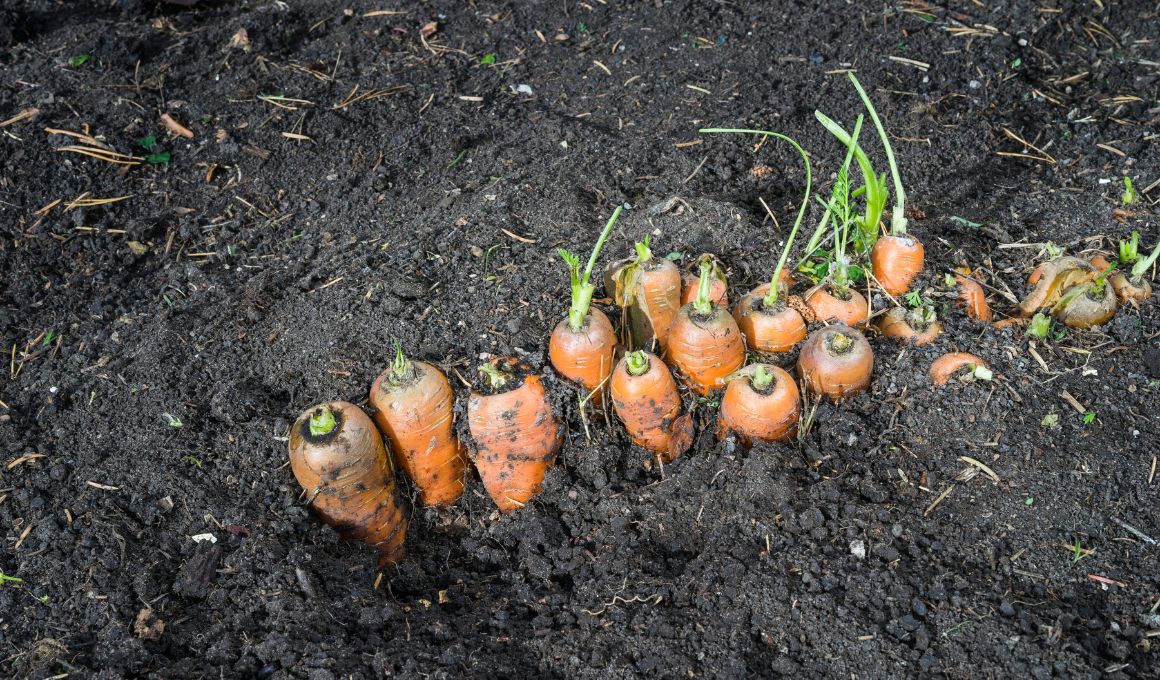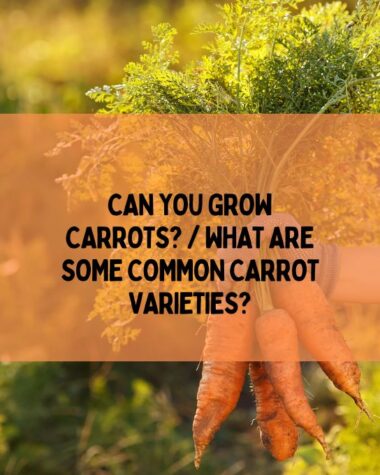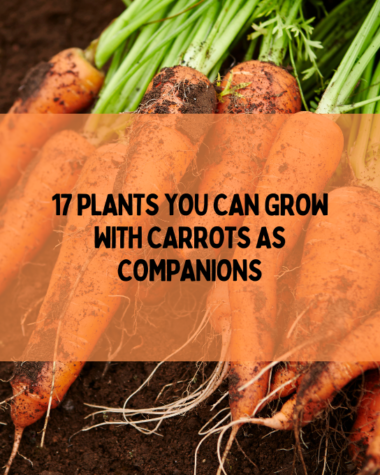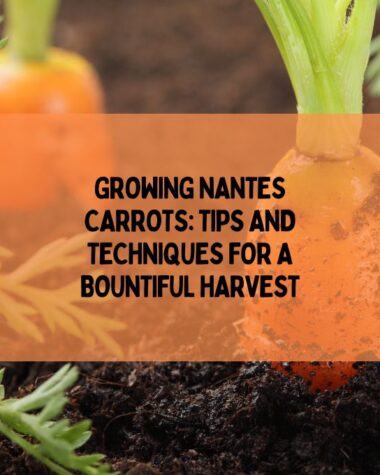How To Harvest Carrots In Your Garden? Preparing the soil and tools, Loosening the soil, and Gently pulling the carrots out of the ground.
Carrots are versatile and nutritious vegetables grown quickly in a home garden. Harvesting carrots at the right time is crucial to ensure they are at their peak flavor, texture, and nutritional value. Harvesting too early or too late can affect the quality of the carrots and result in a less satisfying culinary experience.
Harvesting carrots at the optimal time is also essential to prevent them from becoming woody, harsh, or bitter. Carrots left in the ground for too long can start to develop a thick core, making them unappealing to eat.
The timing to grow carrots and harvest also depends on the intended use of the vegetable. If you plan to use the carrots for juicing or canning, you may want to harvest them when they are smaller and more tender. If you are using them for cooking or eating raw, you may prefer to wait until they are more mature and have a more robust flavor.
Harvesting carrots involves several steps, including preparing the soil, planting the seeds, caring for the plants, and harvesting mature carrots. When the carrots are ready to harvest, you’ll need to carefully dig them out of the ground and remove any excess soil.
Once harvested, the carrots can be stored in a cool, dry place for several weeks, depending on the variety and the conditions. You can also preserve them by canning, freezing, or pickling.
This guide will provide a detailed overview of the harvesting process, including when to harvest carrots, prepare the soil, and care for the plants to ensure a bountiful harvest of flavorful and nutritious carrots.
Step-by-Step Guide on How to Harvest Carrots

Harvesting carrots is a straightforward process that can be done with a few simple steps.
- Preparing the soil and tools: Before harvesting, ensure the soil around the carrots is moist but not waterlogged. This will make it easier to remove the carrots without causing damage. You’ll also need a garden fork or a spade to loosen the soil around the carrots.
- Loosening the soil: Use a garden fork or spade to carefully loosen the soil around the carrots. Be sure to dig deep enough to avoid damaging the roots.
- Gently pulling the carrots out of the ground: Once the soil around them is loosened, grasp the tops and gently pull them out. Be careful not to yank or twist the carrots, which can cause damage. If you encounter any resistance, gently loosen the soil around the carrot and try again.
Related Read
- Growing Nantes Carrots: Tips And Techniques For A Bountiful Harvest
- How To Grow Delicious Danvers Carrots?
- How To Grow Imperator Carrots?
Tips for Harvesting Carrots
Here are some tips to help you harvest carrots successfully:
- How to handle the carrots to avoid damage: Handle them gently to avoid damaging them. Avoid pulling them out by the leaves or tops, as this can break the carrots or cause them to split. Instead, grasp the tops of the carrots and gently pull them straight up.
- How to store carrots after harvest: Remove excess soil and trim the carrot tops to about 1/2 inch. Store the carrots in a cool, dark place like a root cellar or refrigerator. You can also store them in a plastic bag or container with a damp paper towel to keep them moist. Carrots can be stored for several weeks, depending on the variety and storage conditions. Avoid storing them with fruits or vegetables that produce ethylene gas, as this can cause the carrots to spoil faster.
By following these simple steps and tips, you can ensure that your carrot harvest is successful and that your carrots are flavorful and nutritious.
Factors That Determine When to Harvest Carrots

Several factors determine when to harvest carrots, including the time to maturity, soil conditions, and weather.
- Time to maturity: The time it takes for carrots to mature varies depending on the variety. Most carrots take 60 to 80 days to mature, but some varieties can take up to 100 days. It’s essential to know the expected maturity date of the variety you’re growing so you can plan accordingly.
- Soil conditions: Soil moisture and temperature can impact the growth and development of carrots. More moisture can affect the size and quality of the carrots. Warm soil temperatures can cause the carrots to grow too quickly, resulting in a less flavorful and tender vegetable.
- Weather: Extreme weather conditions like frost, drought, and the excessive heat can also impact carrot growth and development. Monitoring weather conditions and adjusting your planting and harvesting schedule is crucial.
Also, Read
- How to Grow Chantenay Carrots?
- Troubleshooting Carrot Growing Problems: Why Won’t My Carrots Develop?
- Indoor Carrot Garden: Tips For Growing Carrots Indoors
Signs to Look for When Carrots are Ready to Harvest

There are several signs to look for to determine if your carrots are ready to harvest.
- Carrot size and color: Mature carrots are usually between 1/2 inch to 1 inch in diameter and 6 to 8 inches long, depending on the variety. The color of the carrot should also be bright and uniform.
- Carrot tops: The tops of the carrots should be visibly protruding from the soil and at least 1 inch in diameter. If the carrot tops are still small, the carrots are not yet mature.
- Soil conditions: The soil around the carrots should be loose and easy to dig. If the soil is compacted, removing the carrots without damaging them may be difficult.
When to Harvest Carrots to Achieve the Best Flavor and Texture
Harvesting carrots at the right time is essential for the best flavor and texture. Carrots that are harvested too early may be underdeveloped and lack flavor. On the other hand, carrots that are left in the ground for too long may become woody and tough.
A good rule of thumb is to harvest carrots between 1/2 inch to 1 inch in diameter and 6 to 8 inches long. You can also do a taste test to determine if the carrots are ready. Gently brush away the soil around the top of the carrot and taste a small piece. If it’s sweet and flavorful, it’s ready to harvest. It may need more time to mature if it’s bitter or lacks flavor.
Conclusion
Harvesting carrots is an essential part of growing this nutritious and flavorful vegetable. Knowing when to harvest and how to do it properly can help you get the best flavor and texture from your carrots. Consider factors like time to maturity, soil conditions, and weather when deciding when to harvest your carrots.
Look for signs like carrot size and color, carrot tops, and soil conditions to determine if your carrots are ready for harvest. When harvesting, handle the carrots gently to avoid damage and store them properly to keep them fresh and delicious for as long as possible. With these tips and techniques, you can enjoy a bountiful carrot harvest from your garden.
Frequently Asked Questions
Q1. What happens if I don’t harvest my carrots on time?
A. If you briefly leave your carrots in the ground, they can become rigid, woody, and less flavorful. Also, carrots left in the ground during freezing temperatures can become damaged or freeze solid, rendering them inedible.
Q2. Can I harvest my carrots in stages?
A. Yes! You can harvest your carrots in stages by gently pulling up a few at a time as they reach maturity. This method allows you to enjoy fresh carrots over an extended period and avoid harvesting all your carrots crop simultaneously.
Q3. How do I know if my carrots are too old to harvest?
A. Carrots left in the ground for too long may become woody, challenging, and less flavorful. To determine if your carrots are too old to harvest, look for signs like overly thick roots or cracks on the carrot surface. Taste a small piece of the carrot to see if it is still flavorful and tender.
Q4. Can I eat the carrot greens?
A. Yes! Carrot greens are edible and can be added to salads, soups, or smoothies. However, the greens can be slightly bitter and harsh, so it’s best to chop them finely and mix them with other greens or cook them before eating.
Q5. Can I leave some carrots in the ground for winter storage?
A. Yes! You can leave some carrots in the ground for winter storage in a region with mild winters. The carrots should be covered with a thick layer of mulch or straw to protect them from freezing temperatures. Be sure to harvest any remaining carrots before the ground freezes solid.
Q6. How do I prepare my garden bed for the next carrot season?
A. Remove any remaining carrot roots and debris from the soil to prepare your garden bed for the next carrot season. Amend the soil with compost or other organic matter to replenish nutrients and improve soil structure. You may also want to rotate crops to avoid soil-borne diseases and pests. Finally, test your soil pH and adjust if necessary to ensure optimal growing conditions for your carrots.







